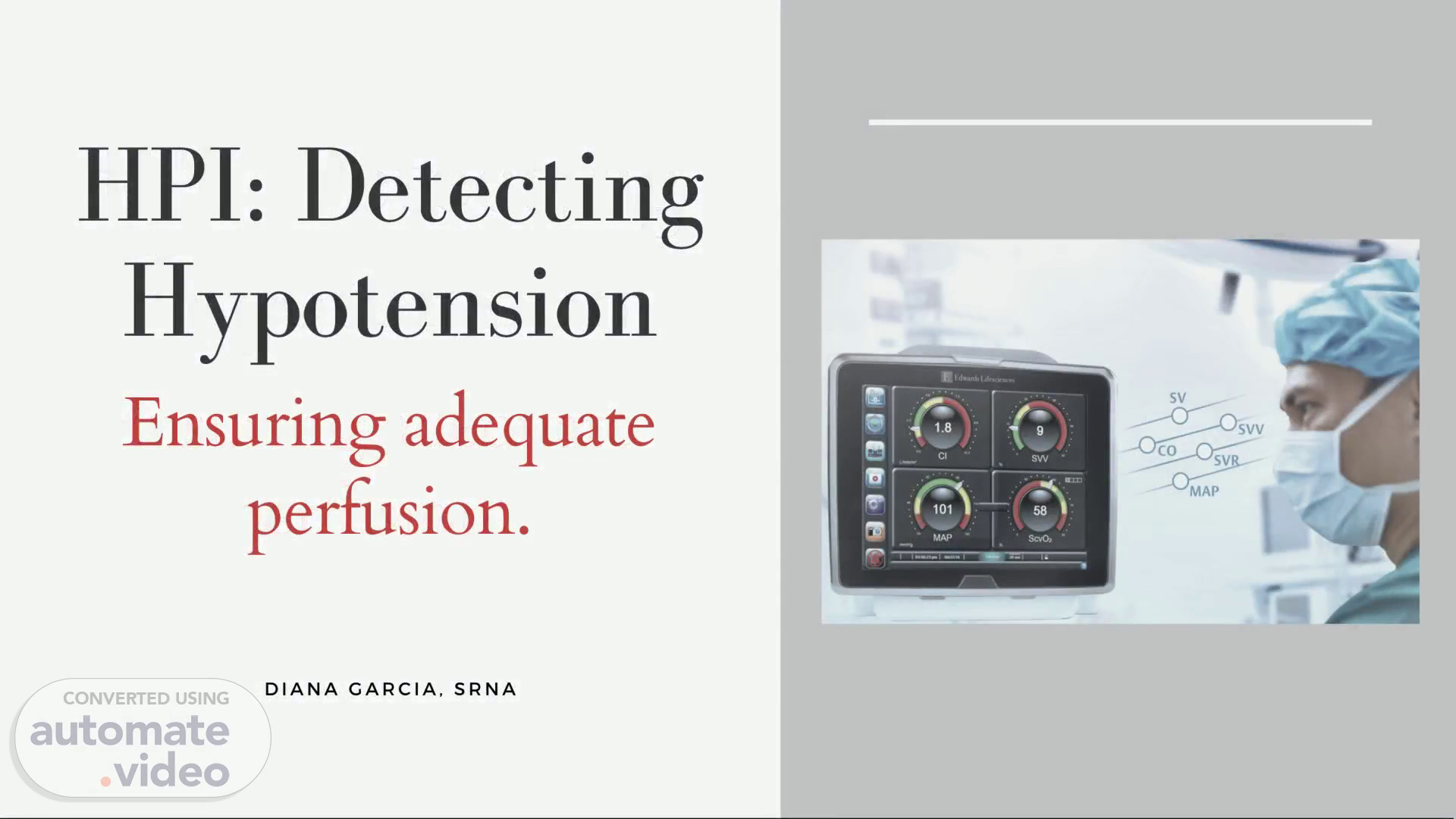Scene 1 (0s)
sv svv co sv MAP. Ensuring adequate perfusion. HPI: Detecting Hypotension.
Scene 2 (11s)
Objectives. IDENTIFY misconceptions regarding hypotension. DISCUSS the importance of hypotension and its consequences if not treated. DEFINE the HPI parameter and its components..
Scene 3 (1m 10s)
Hypotension: MAP <65 mmHg for 1 minute. Use of minimally invasive system, provides access to advanced hemodynamic parameters (CO, SV, SVV, & SVR) that allow you to evaluate hemodynamic instability and guide appropriate treatment. 88% of patients with arterial lines still experienced hypotensive events. Proactive Intraoperative Hypotension Management.
Scene 4 (2m 52s)
Why should we care?.
Scene 5 (5m 8s)
Why should we care?.
Scene 6 (7m 11s)
ADEQUATE BLOOD PRESSURE MAY NOT MEAN ADEQUATE PERFUSION.
Scene 7 (7m 58s)
O minutes 1 to 5 minutes 6 to 10 minutes 11 to 20 minutes minutes 6 1.5 2 Adjusted Odds Ratio 2.5 Acute Kidney Injury Cardiac Complication Myocardial Injury.
Scene 8 (11m 14s)
DEVICES. Arterial line. FLOTRAC. Finger Cuff. CLEARSITE.
Scene 9 (11m 52s)
What is HPI ?. Hypotension Prediction Index. Provides you with information regarding the likelihood of a patient trending toward a hypotensive event. Range from 0-100. Gives a new number every 20 seconds, with higher numbers indicating a higher likelihood of a hypotensive event. Multiple studies have shown that Acumen HPI software: Achieves statistically significant reduction of hypotension when combined with a treatment protocol in noncardiac surgery vs. standard of care. Acumen HPI software has demonstrated a reduction in the duration of IOH by 57%. Demonstrates superior predictive abilities for hypotension than common hemodynamic parameters such as cardiac output (CO), stroke volume (SV), and changes in mean arterial pressure (MAP)..
Scene 10 (12m 47s)
100 90 80 70 60 50 40 30 20 10 7 minutes .6 .43 .N Tme 100 80 20 — MAP — HPI.
Scene 11 (13m 31s)
Contractility Contractility 160 features Stroke volume peripheral effects Afterload Compliance Vascular tone Full cardiac cycle aortic compliance.
Scene 12 (14m 31s)
Mwards Lif esciences MAP dP/dt 'f 00 70 515 Change SVR •co 3.5 • SV 55 16 1486 104/73 (82).
Scene 13 (14m 40s)
Mwards Lif esciences MAP dP/dt 'f 00 70 515 Change SVR •co 3.5 • SV 55 16 1486 104/73 (82).
Scene 14 (14m 58s)
Preload. Afterload. Contractility. *Let MS. Eadyn 1.2 '/dt Arterial Elastæxe (.PMSVV).
Scene 15 (15m 18s)
Start Evaluate: dPldT increase? Elastance normalised? HPI 50-85 Diagnose cause or MAP<65 Advice: Start treatment < 2 minutes Two criteria present SVR SW t Yes Advice: Most likely cause vasoplegia No Two criteria present Eadyn t SW t sv Yes Advice: Most likely cause hypovolemia No If no condition is satisfied treat hypotension without advise No Three criteria present SVR sw = sv Yes Advice: Most likely cause reduced LV contractility Treatment started by anesthetist.
Scene 16 (16m 17s)
Low Ea (10/15) = 0 67 PPV 25% ppv 10% sw 15% sw 15% High Ea (25/15) = 1.67 Volume.
Scene 17 (18m 8s)
Davies, S. (2021). Managing Intraoperative Hypotension with a Predictive Parameter Part 2. [Video]. https://www.youtube.com/watch?v=SzfFnF4j624 Edwards Life Sciences. (2021). Acumen Hypotension Prediction Index Software. Retrieved from https://www.edwards.com/gb/devices/decision-software/hpi Edwards Life Sciences. (2021). Edwards Clinical Education. Retrieved from https://www.edwards.com/gb/clinicaleducation Edwards Life Sciences. (2021). Intraoperative Hypotension Matters. Retrieved from https://www.edwards.com/gb/therapies/hypotension-management# Edwards Life Sciences. (2021). Methods for Assessing Fluid Responsiveness. Retrieved from https://educationgb.edwards.com/fluid-responsiveness-in-the-critically-ill-patient-svvplr/72010# Khanna, A. (2021). Managing Intraoperative Hypotension with a Predictive Parameter Part 1. [Video]. YouTube. https://www.youtube.com/watch?v=Jp9-5uqWDeo&t=685s.
